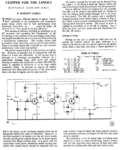neazoi
Advanced Member level 6
What is the key difference between an audio logarithmic amplifier and an audio logarithmic clipper, if both are used in communication receivers?
My guess its that, the audio logarithmic amplifier, amplifies logarithmically both high level and low level signals, within the passband of the amplifier. However I am not sure what will happen if both high level and low level signals exist simultaneously. Will the low level signals amplified more and at the same time, the high level ones amplified less? Or will the high level signals mask the low level ones?
However in an audio logarithmic clipper all signals are amplified logarithmically, but at some point the high level signals are clipped.
I may be wrong though.
My guess its that, the audio logarithmic amplifier, amplifies logarithmically both high level and low level signals, within the passband of the amplifier. However I am not sure what will happen if both high level and low level signals exist simultaneously. Will the low level signals amplified more and at the same time, the high level ones amplified less? Or will the high level signals mask the low level ones?
However in an audio logarithmic clipper all signals are amplified logarithmically, but at some point the high level signals are clipped.
I may be wrong though.
